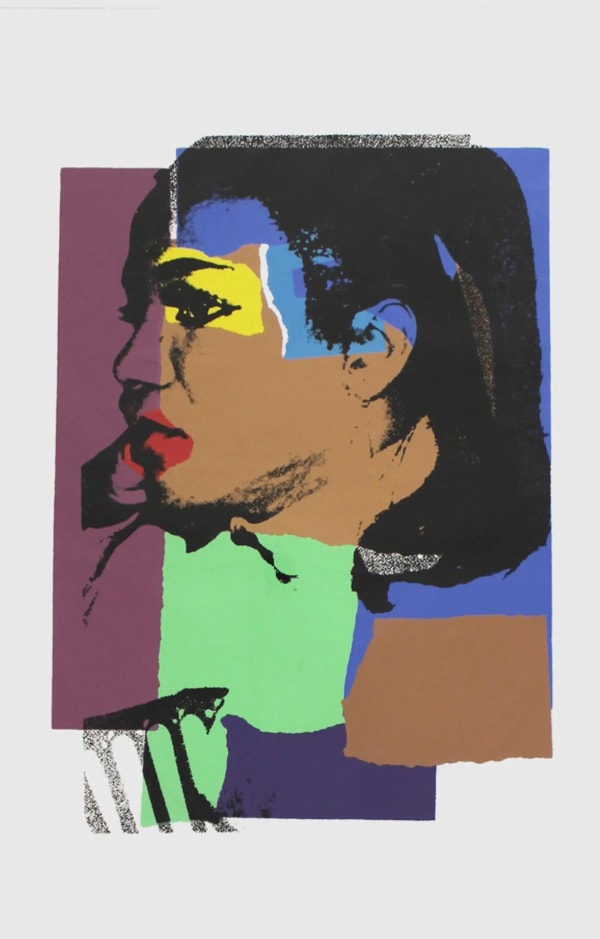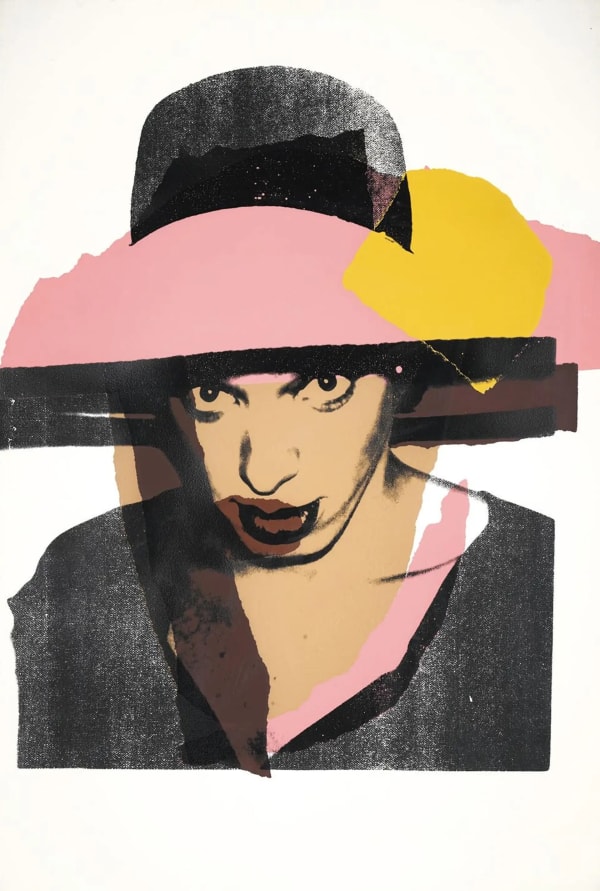
Andy Warhol
111.1 x 73.3 cm
Ladies and Gentlemen FS. II 127 is part of Andy Warhol’s groundbreaking Ladies and Gentlemen series, created in 1975. The portrait reflects Warhol’s fascination with marginalized identities, particularly African-American and Hispanic drag performers he encountered at The Gilded Grape—a nightclub in New York City known for its vibrant and diverse clientele. This piece, like others in the series, captures a powerful blend of vulnerability and confidence, rendered through Warhol’s signature silkscreen process.
Ladies and Gentlemen FS. II 127 shows Warhol’s use of vivid, almost electric colors contrasts with delicate pencil shading. The sitter’s long lashes and pouty lips evoke a heightened femininity, while color blocks across the face draw attention to more traditionally masculine features—such as a defined jawline and traces of facial hair. This tension between presentation and perception is at the heart of the work, revealing both the performance and the reality of gender expression.
The Ladies and Gentlemen series consists of over 500 portraits of drag performers and transgender individuals, all of whom were photographed by Warhol using his Polaroid Big Shot camera. He invited his models—none of whom were widely known celebrities—to dress and pose as they pleased. By granting his subjects this autonomy, Warhol allowed them to express themselves freely, imbuing each portrait with unique energy, personality, and style.
Warhol applied the same technique he used to immortalize stars like Marilyn Monroe and Elvis Presley—photographing his subjects, transferring their image to silkscreen, and applying bold, expressive color palettes. In doing so, he elevated these overlooked figures to the status of icons, capturing their glamour, complexity, and resilience.
The idea for the series was suggested by art dealer Alexander Iolas’s associate, Luciano Anselmino, who had previously commissioned Warhol for a series of Man Ray portraits. During a visit to Turin to sign those prints, Anselmino proposed that Warhol create a new body of work centered on drag queens. Inspired, Warhol returned to New York and found his models at The Gilded Grape on West 45th Street—a venue frequented by Black and Hispanic trans performers.
More than just portraits, the Ladies and Gentlemen works challenge the viewer to confront ideas around gender, race, fame, and visibility. Ladies and Gentlemen 127 is a striking example of how Warhol blurred the lines between celebrity and anonymity, art and identity, and in doing so, brought marginalized voices to the forefront of contemporary art.
-
 Andy Warhol, Ladies and Gentlemen F.S. II 132, 1975
Andy Warhol, Ladies and Gentlemen F.S. II 132, 1975 -
 Andy Warhol, Ladies and Gentlemen F.S. II 128, 1975
Andy Warhol, Ladies and Gentlemen F.S. II 128, 1975 -
 Andy Warhol, Ladies and Gentlemen F.S. II 137, 1975
Andy Warhol, Ladies and Gentlemen F.S. II 137, 1975 -
 Andy Warhol, Ladies and Gentlemen F.S. II 136, 1975
Andy Warhol, Ladies and Gentlemen F.S. II 136, 1975 -
 Andy Warhol, Ladies and Gentlemen F.S. II 134, 1975
Andy Warhol, Ladies and Gentlemen F.S. II 134, 1975 -
 Andy Warhol, Ladies and Gentlemen F.S. II 135, 1975
Andy Warhol, Ladies and Gentlemen F.S. II 135, 1975 -
 Andy Warhol, Ladies and Gentlemen F.S. II 131, 1975
Andy Warhol, Ladies and Gentlemen F.S. II 131, 1975 -
 Andy Warhol, Ladies and Gentlemen F.S. II 133, 1975
Andy Warhol, Ladies and Gentlemen F.S. II 133, 1975 -
 Andy Warhol, Ladies and Gentlemen F.S. II 129, 1975
Andy Warhol, Ladies and Gentlemen F.S. II 129, 1975 -
 Andy Warhol, Ladies and Gentlemen F.S. II 130, 1975
Andy Warhol, Ladies and Gentlemen F.S. II 130, 1975
Join our mailing list
* denotes required fields
We will process the personal data you have supplied in accordance with our privacy policy (available on request). You can unsubscribe or change your preferences at any time by clicking the link in our emails.
177 10th Avenue
Ground Floor
New York, NY 10011
Tuesday - Friday 10am - 5pm
Saturday 11am - 5pm
info@guyhepner.com
+1 (212) 500 8190
This website uses cookies
This site uses cookies to help make it more useful to you. Find out more about cookies.









